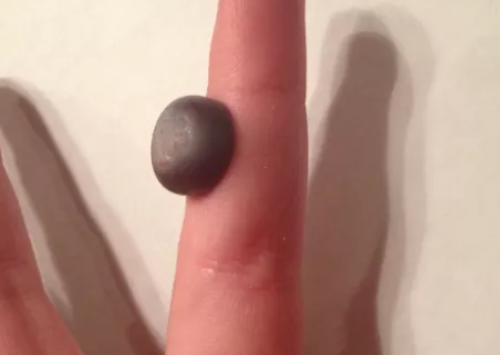Just noticed a blood blister on finger? A blister under finger nail is infected if it won’t go away. Small blood blister between finger knuckles and joints can hurt if they are inflamed. The page will address the underlying causes and possible treatment options including home remedies on how to get rid.
A blister forms when the skin is damage, the upper layer remains intact and fluids collects within the epidermis. That is the upper layer of the skin remain intact and the lower layer becomes raptured. The damage can be through friction, heat or cold or exposure to very reactive chemicals. The blister may also be formed as a result of an underlying medical condition such as impetigo or eczema.
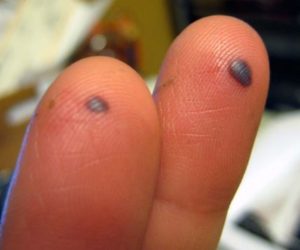
Most of the damage done on the skin by external exposure clears up on itself whereas those caused by an underlying medical condition should be checked by professional health care provider. You should not pop the blister. Doing so opens up your inner skin for bacterial or viral infection. Popped blisters are also painful as the nerves beneath the skin get exposed.
Pictures of blood blister on finger
The following images will help you understand how blood blisters on finger look like. For illustrative purpose, we have added more pictures throughout the post. The essence is to give you a visual aid on the appearance of blister on the finger.
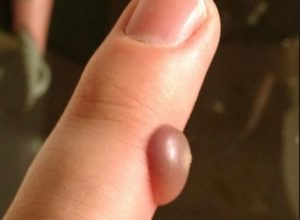
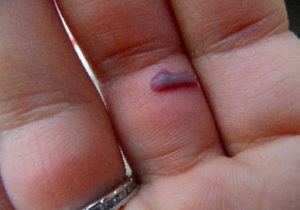
What causes blood blister on finger?
A blood blister on finger can be caused by one or a combination of the following.
1. Trauma or injury
Blister are formed when the blood vessel underneath the skin become damaged. The common cause of this is trauma such as forceful pinching of the skin or general accidents causing injuries.
This is a normal bister and usually heal on its own. It take a maximum of around 1o days and it will be gone unless infected.
Restrain from popping the blister to prevent fugal and bacterial infection. A simple warm compress can help speed up the healing process.
2. Fungal skin infection
The other possible cause of blood blister on finger and hand is fungal infection. This is caused by a fungus known as Tinea manuum, and causes infection in either one or both hands. The fungus is a much less common form of the fungus compared to tinea pedis, this is the fungus affecting the foot.
The blisters formed may have a rash, contains a sticky clear fluid, itches and burns. The fungal infection can be through;
- Contact with an infected person
- Contact with the fungus through contaminated objects such as towel
- Directed contact with an infected animal
Manual workers are more at risk of contacting the fungus.
3. Viral infection
Viral infection is the other possible cause of blood blister on finger. A common cause is varicella zoster virus that cause chicken pox and shingle. An important point to note about chicken pox is that, once infected with the condition the body develops antibodies making you immune to future infection. The virus however does not leave your body making you prone to shingles attacks.
The other virus that might cause blistering is herpes simplex virus which is responsible for herpes. Treating this kind of blister involves first treating the cause before you can treat the symptoms. You need to have a professional health care provider look at it to facilitate treatment.
Most of this virus are highly contagious, so please reduce contact with infected people to minimize the chances of the virus spreading.
4. Impetigo
Impetigo is a common cause of sores and blood blisters on skin of children and young adults. The condition is highly contagious but not very serious as it can clear on its own without any medical treatment given.
The symptoms of impetigo include;
- Red sores that burst to leave behind thick golden crust
- A painless itch sore
- High fever
- Swollen lymph nodes
- Blisters that quickly spread
- Itchy and painful blister (bullous impetigo)
The condition is in most cases not serious. But for effective treatment, you need to have the condition diagnosed since at times it may have symptoms common to a more serious condition such as cellulitis an infection of deeper skin layer
Antibiotic creams and tablets are the common treatment option for impetigo.
5. Medical allergy
Drug allergy or what we are calling medical allergy is the other possible cause of blood blister on finger and other parts of the body. An allergy is defined as the response of the body’s immune system to allergens’, in this case the drugs we take such as antibiotics, anti-inflammatories or over-the-counter painkillers.
The common symptoms of drug allergies include;
- Itchy eyes
- Running nose
- All sort of skin rash
- Blisters and sore on skin
Treating a drug allergy can be done by discontinuing the use of the reacting drugs. For severe cases, steroids and antihistamine tablets and creams can be used. Please avoid over-the-counter medication and visit a professional health care provider for diagnosis.
6. Eczema
A specific type of eczema known as pompholyx has been found to cause tiny blister that develop across the fingers, palm and hand. Also known as dyshidrotic eczema, it affect people of any age but it is most often seen in people under 40 years of age.
This condition usually starts as intense itching and burning skin. Then it erupts into tiny itchy blister that may weep fluids. The common cause of this condition has been found to be
- Fungal infection
- Excess sweating
- Stress
- Chemical and other allergic reactants
Mild cases of the condition usually clears on their own for about a week or two. However, topical ointment and skin emollients may be used to speed up the healing process. Steroid creams can be used to reduce the irritation and inflammation.
Other cause of blood blisters on fingers will include the following:
- Burns
- Frostbites
- Sun burn
- Friction with rough surface
- Chemical exposure
Blood blister on finger joint won’t go away
When you have a blood blister on finger and it fails to heal for about two weeks you need to see a professional health care provider as soon as possible. The main reason a blood blister will fail to heal or go away is when it is infected or the underlying medical condition causing the blister is not treated.
When you pop a fresh blister, the nerve underneath are exposed leaving them prone to either a viral or fungal infection. The blister will now be filled with pus. The skin around the blister also changes in color, become swollen and feels tender when touched. An infected blister is also painful and may make you more uncomfortable.
An infected blister requires immediate medical attention to prevent the infection from spreading to other parts and managing the symptoms. The wound formed should be washed with antiseptic fluid and wrapped in a clean bandage. Antibiotics and mild soap can be used when cleaning the wound.
Small blister on finger under skin infected
Once a blister start to swell and get painful, it is because of an infection. The outer epidermis or the covering of the blister ruptures, fluid such as serum, pus and blood drains out. The inner nerve are exposed making the blister painful.
For a ruptured blister, wash it with mild soap or methylated spirit, you can dry it up with hydrogen peroxide and wrap it in a bandage. Anti-bacterial or anti-fungal gel may be used to protect the wound from infection.
An infected blister has the following symptoms;
- Swelling finger and around blister
- Increased pain
- The blister drains pus
- Redness around the blister
- The blister feels warm
- It is possible to have fever
Blood blister under finger nail hurts
A blood blister under finger will continue to hurt if the cause of the blister is not stopped. For example, if the cause of the blister is pressure, when you continue exacting pressure on the finger nail will cause the blister to keep hurting until you stop.
The other possible reason that will make blister to hurt is when the blister is infected. A blister will be infected if you pop it and leave it in the open. Bacterial and fungal infection are the main cause of infection of the blister.
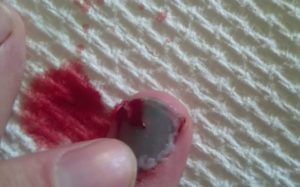
Antibiotics and painkiller can be used to relieve the pain. You need to see a doctor to examine the extent of the infection.
How long to heal a blood blister on finger?
Normally a blood blister on finger will heal naturally for about 3-5 week. You should be careful not to pop the blister, this leave you prone to an infection and healing the blister may take more than the normal time.
Keep the blister clean. You can wash the blister with warm water and a mild soap. In case the blister pops, wash it with antiseptic solution, apply antibiotic ointment and keep it closed in a clean dry bandage.
Should I Pop blood Blister on my Finger?
The unwritten rule with blood blisters is that you should not pop the blister no matter what. The outer layer of the blister protects the finger from both bacterial and fungal infection.
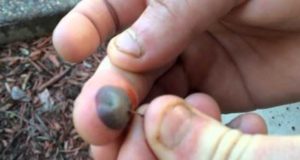
Popping the blister exposes you skin for infection. A blister infection will cause the finger to swell or become inflamed. The exposed never makes the blister more painful and discomforting.
Blood blister on finger knuckle
Finger knuckle is the part where the finger joins the hand. As we have seen above, a blood blister is formed when a lot of pressure is exacted on the skin. What happens is the inner or lower epidermis ruptures whereas the upper epidermis remains intact trapping fluids such as blood, pus and plasma, the collection and accumulation of this fluid forms dark bump that we are calling a blister.
The common causes of blisters on finger will thus include, friction with a rough surface, trauma and injuries or sun burn. A part from this physical cause, a blister on finger may also be formed by chemical exposure, sun burn especially for children and those with soft skin and frostbite.
A blood blister on finger can also be caused by an underlying medical infection, bacterial infection and fungal infection. Impetigo and medical allergies are also among common causes.
A common thing with most blisters is that you should not pop them. Most blisters will heal on they own without any medical attention given. However, some topical anti-fungal and anti-itching creams maybe used to speed up the heal process.
Other medical condition that might cause a blister to form on knuckle include the following,
- Chicken pox
- Impetigo a contagious bacterial infection
- Cold sores
- Hand disease especially viral infection
How to treat a blood blister on finger- Tips to treat
Treating a blood blister on finger will involve preventing the blister from rupturing and also reducing the swelling and pain involved. To do this, you will need to use a blister plaster which will reduce further irritation and protect the weak layer covering the blister.
Clean the blister with warm water and antiseptic solution to kill all the germs that might cause an infection. For ruptured blister, antibacterial solution should be used to ensure the wound is clean and safe from germs.
Topical ointment suck as anti-itching and anti-swelling creams and gel can be used to reduce the swelling and pain associated with the blister.
How to get rid of blood blister on finger – Home remedies
Blood blister on finger are not life threatening, we have already said that most of them will take around 3 weeks and to heal on their own. What you need not to do is to pop the blister open as this leaves your skin prone to an infection.
When the blister becomes unbearable and it is making it hard to use the hand with the blister, then you can make a decision to pop it, but take note, that should be been in the right way with clean and sterilized tools.
This is how to do it:
- Wash clean the finger or hand with the blister with warm clean water and a mild soap
- Using alcohol or hydrogen peroxide, disinfect the blister
- Disinfected and sterilize a sharp need
- Puncher the blister around the edge to drain it’s content and leave the outer skin intact
- Squeeze all the contents of the blister
- Apply antibiotic ointment and the remaining wound
- Cover the wound with a clean dry bandage
- After a week cut the dead skin covering the blister
Sources and references:
- http://healthool.com/blood-blister-on-finger/
- http://www.livestrong.com/article/323942-skin-blisters-that-dont-heal/
- http://www.nhs.uk/Conditions/Blisters/Pages/Causes.aspx
- http://www.livestrong.com/article/18160-treat-blisters-hands/
- http://www.top10homeremedies.com/how-to/how-to-get-rid-of-blood-blisters.html
- http://www.dermnetnz.org/topics/tinea-manuum/
- http://www.nhs.uk/Conditions/pompholyx/Pages/Introduction.aspx
- http://www.nhs.uk/conditions/impetigo/pages/introduction.aspx
